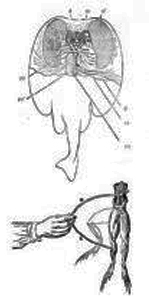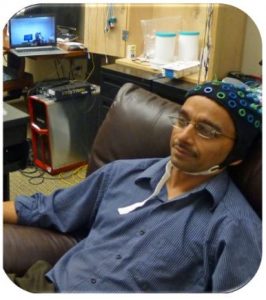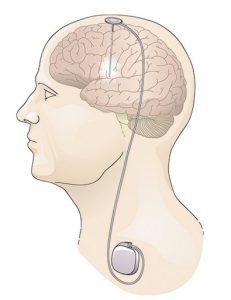3 Brain and Spinal Cord Stimulation
Welcome to the third day of the Virtual REACH Program! Yesterday you heard from CNT co-Director Dr. Raj Rao about Brain-Computer Interfaces. Today you will hear from the other CNT co-Director, Dr. Chet Moritz, about a different neurotechnology known as neurostimulation. The resources below include a brief history of electrical stimulation of the nervous system, an overview of the main types of neurostimulation techniques, and a research spotlight focused on the work of Dr. Chet Moritz and his team. Additional resources are provided if you would like to explore another example of neurostimulation, Deep Brain Stimulation (DBS).
Part One: History of Electrical Stimulation of the Nervous System
A bit of history about electrical stimulation of the nervous system:
- The ancient Eqyptians, Greeks and Romans used torpedo fish to treat headache, epilepsy, depression and other conditions. The torpedo fish can generate up to 220 V of electricity with modified muscle tissue.
- In the mid-1700s, Luigi Galvani demonstrated that electricity could make a frog leg twitch. Alessandro Volta showed that biological electricity is similar to other types of electricity; he also invented the battery.
- In the mid-1800s, Gillaume Duchenne applied electricity to muscles of people to show that muscles could be controlled electrically.
- In the mid-1900s, neurosurgeons applied electricity directly to the surface of the brain to cause sensation and movement.
Part Two: Neurostimulation Techniques
With neurostimulation, there are several ways that the nervous system is stimulated:
- Microelectrodes: activate a population of neurons (axons) close to the electrode. The number of neurons depends on stimulation parameters and large neurons and those neurons near the electrode are activated by lower currents. Microelectrodes are used for deep brain stimulation, cochlear implants, cortical surface, and spinal cord stimulation. Electrocorticography (ECoG ) electrodes are placed on the surface of the brain and may activate several thousands of neurons.

- Optical stimulation (Optogenetics): requires both light and genetic manipulation to control neurons.
- Transcranial magnetic stimulation: a magnetic field passes through skin and skull, inducing an electric current in the brain. The maximum depth that magnetic stimulation reaches is 3-5 cm.
- Transcranial ultrasound: sound waves travel through bone and soft tissues. Low-intensity pulsed ultrasound influences neural activity without heating the tissue.
Part Three: CNT Research Spotlight
Today, Dr. Chet Moritz will share how he and his team at the University of Washington are using neurostimulation to help rehabilitate spinal cord injuries. In this section, you will watch a news video and read two articles. Then contribute to today’s Padlet.
Watch & Read This!
Learn about the spinal cord rehabilitation work in the Moritz lab by exploring all three of these resources. These resources tell the story of Joe Beatty, who was paralyzed due to a spinal cord injury experienced during a body-surfing accident while vacationing in Hawaii.
- KING 5 News video. In this short video, you will see how the Moritz lab has helped Joe regain important bodily functions.
- New, non-invasive treatment improves hand and arm function in people with spinal cord injury Read how CNT researchers have helped Joe, and other study participants, regain hand and arm function.
Try It!
After watching the news video and reading the article, respond to this question on a Padlet:
- What questions do you have for Dr. Moritz and his team?
Post your questions to this Questions about Spinal Cord Stimulation Padlet. See what other VRP participants have posted as well. You can “favorite” the ones you agree with or add comments.
Then, hit the “back” arrow on your web browser to return to this chapter and keep reading.
Part Four: Deep Brain Stimulation
Another example of neurostimulation is Deep Brain Stimulation (DBS). Deep brain stimulation (DBS) is a technology that was originally developed as a treatment to help control the debilitating symptoms of Parkinson’s disease, but now being used to treat many other conditions. These other conditions include essential tremor, dystonia, epilepsy, and obsessive compulsive disorder. A deep brain stimulator consists of a device, similar to a cardiac pacemaker that is surgically

implemented near the neck, that delivers electrical signals to an electrode implanted in the brain tissue. It required invasive brain surgery, but for many patients, DBS therapy has improved their quality of life. Learn more about deep brain stimulation by exploring the optional resources below. In addition, tomorrow’s learning resources will include some information about how neuroethicists have grappled with the ethical implications of DBS treatments and their impacts on the patients who receive them.
Optional: Learn about Deep Brain Stimulation (DBS)
Learn about deep brain stimulation (DBS), a technology that was originally developed as a treatment to help control the debilitating symptoms of Parkinson’s disease, but now being used to treat many other conditions, including essential tremor, dystonia, epilepsy, and obsessive compulsive disorder.
- The Cleveland Clinic provides an introduction to Deep Brain Stimulation. Click through the tabs to learn about the surgical procedure, risks/benefits, and recovery process.
- Watch a video on Engineering Improvements to Deep Brain Stimulation that shows how CNT researchers helped treat the tremors from Parkinson’s disease for their study participant, Fred Foy.
- Read an article and watch a video that shows how DBS can help reduce the symptoms of essential tremor: “Brain Signals Deliver First Targeted Treatment for World’s Most Common Movement Disorder.”
Tomorrow we will discuss the field of neuroethics with Dr. Ishan Dasgupta. Dr. Dasgupta works with the CNT Neuroethics program that seeks to better understand the ethical issues arising from emerging neural engineering technologies.
Citations:
- Photo credits: Center for Neurotechnology.
- DBS illustration: National Institute of Neurological Disorders and Stroke.
Very small electrodes used for either recording neural signals or for electrical stimulation (i.e., electrical stimulation of the brain or spinal cord).
A technique for recording the electrical activity of the brain obtained from electrodes placed on the surface of the brain. ECoG is an invasive way to record signals from the brain, requiring surgery to access the brain’s surface.
A technique used by neuroscientists that uses both light and genetic manipulation to control neurons. Neurons are genetically manipulated to be light-sensitive, thus enabling light to cause neurons to fire.
A non-invasive method of stimulating neurons in the brain in which a magnetic field passes through the skin of the scalp and the skull, inducing an electric current in the brain. The maximum depth that magnetic stimulation reaches is 3-5 cm.
A non-invasive technique in which sound waves travel through bone and soft tissues to the brain. Low-intensity pulsed ultrasound influences neural activity without heating or damaging the tissue.
A device in which electrodes are surgically implanted into brain tissue and connected to an impulse generator implanted under the skin. The device directs targeted, painless electrical pulses to a specific area of the brain.

